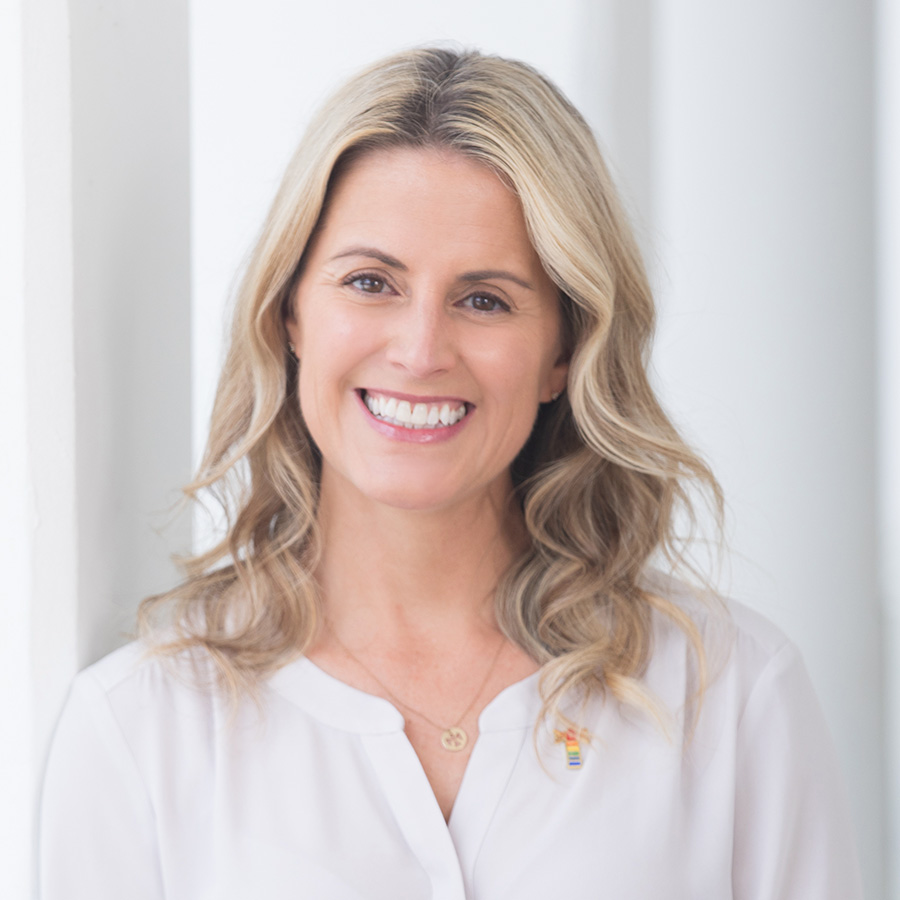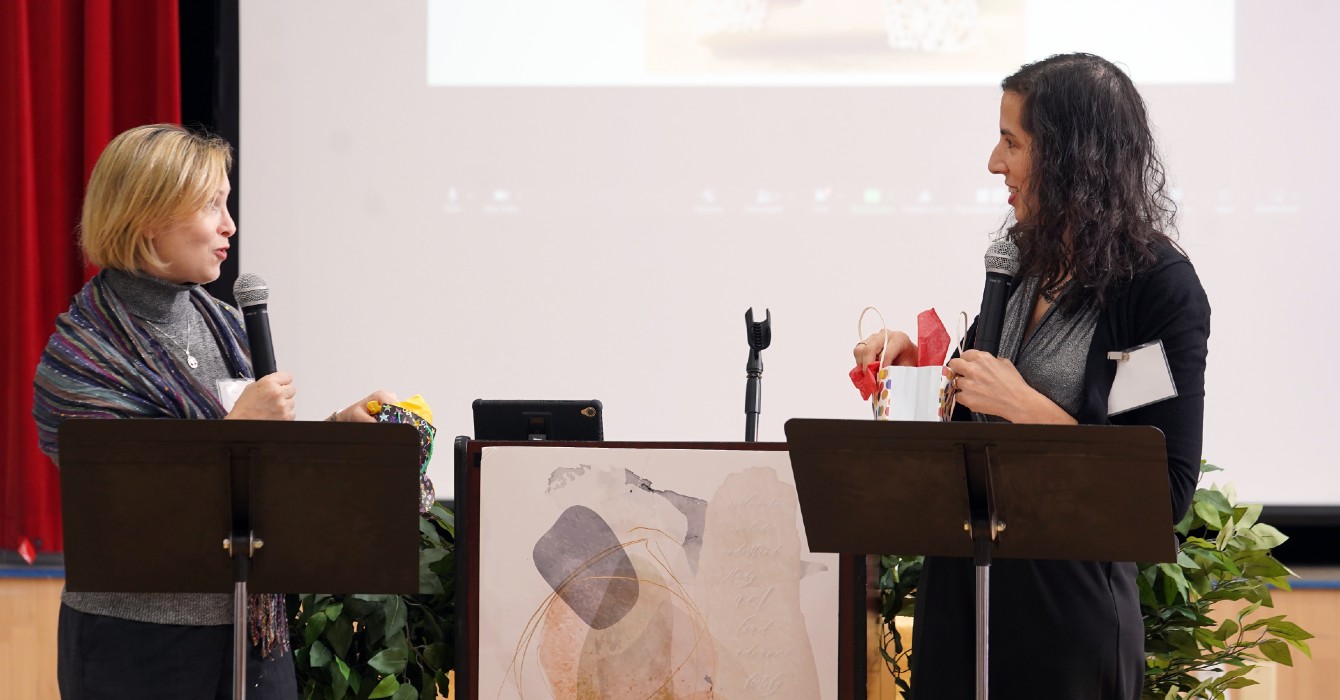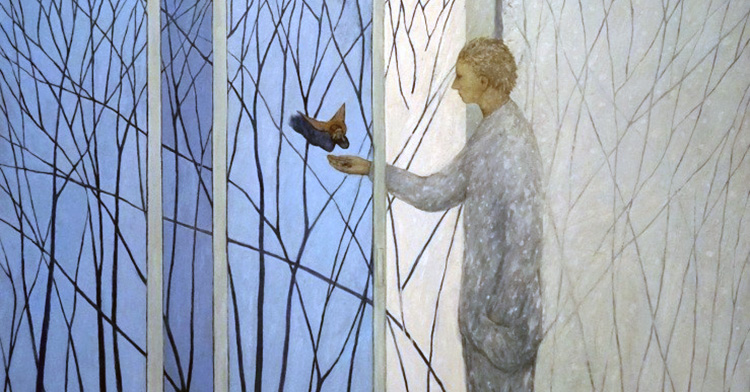Jaki Negreros, 24, is standing on a bench in the center of a spacious art studio in Spring Branch, Texas. From this vantage point, she easily commands the attention of more than a dozen teens, ages 14 to 17, who sprawl around shiny laminate worktables ready for an after-school art class.
“Today, we’re going to do a pass-the-card exercise,” Negreros says, handing out paint, brushes and bright yellow mixing cups. Each person gets a 5-by-8-inch card and adds his or her name to the back before Negreros begins a series of art prompts.
“Add 20 dots to the card, and then pass it to the next person,” she says. Every time a work-in-progress changes hands, Negreros adds a new prompt. Music plays in the background as conversation flows in English and in Spanish.
The classroom where the teens are working belongs to Newspring, a faith-based nonprofit in Spring Branch (pop. 120,000), a section of Houston that is home to a large working-class community and a large second- and third-generation Hispanic, Korean and Vietnamese immigrant population.
Founded in 2006, Newspring’s visual arts program is part of a unique economic development effort that aims to provide what President and CEO Denton Ragland calls “systems of opportunity.” Such systems offer an integrated spiritual, creative and professional response to the area’s economic instability and lack of opportunity.
Founder Robert Westheimer came up with the idea of this ministry after helping to plant a Spanish-language church in the area but realizing it couldn’t sufficiently address the residents’ economic needs.
“Our calling shifted from the church plant to Newspring in an effort to improve the economic plight of the community,” he said.
Newspring’s visual arts program, a partnership with the local school district, is thriving. Negreros herself, a Spring Branch native, former Newspring student and recent graduate of the University of Texas at Austin in studio art, is a shining example of what the organization hopes to achieve.
Young artists
Newspring’s current programming grew out of many conversations with local leaders, especially at the local school district and community college. It was during a visit with a middle school principal -- as Westheimer admired the student artwork on display -- that the idea for a visual arts program took root.

“I know these kids are good,” the principal said. Soon, art became the channel for engaging students and their families, and encouraging them to think about careers beyond grass cutting, housecleaning and other low-paying work.
“We didn’t start Newspring with a five-year plan,” Westheimer said. “We saw just how talented the kids were, and so we started thinking about starting an art program. It’s like a lot of things we’ve done -- God working through collaborating people.”
Today, Newspring’s art ministry includes after-school lessons, a popular annual art auction, a 10-week summer art camp, in-school visits by professional artists, internships, and even scholarships for higher education.
Students ages 8 to 18 attend free art classes at the main Newspring studio and two satellite locations, said Newspring’s visual arts director, Carol Andrews. For the past few summers, the art camp has been staffed partly by Newspring’s high school and college student alumni, allowing them to gain valuable teaching and internship experience.
Andrews, a professional photographer and Spring Branch native, volunteered for Newspring for about six years before joining the small staff about 18 months ago. The program she leads places a wide variety of professional visual artists in the classrooms to talk about how to make a living.
“It opens up career possibilities for them,” Andrews said. She sends sculptors, painters, and even interior designers and architects into art classrooms in the surrounding school district. “I locate all kinds of different artists. Last year, we created a school assembly for 800 students and invited an ice sculptor. His whole message was, ‘Don’t let anybody tell you no.’”
Andrews has also arranged for field trips to the studio of Houston painter Justin Garcia and to the Museum of Fine Arts, Houston. “[The museum trip] was life-changing,” she said.
In the studio, “Mama C,” as Andrews is known, pushes the young artists to learn professional presentation skills, like writing an artist’s statement and developing a portfolio.
Such life skills for artists are transferable to any profession, Andrews said. “Our art students who graduate from Newspring are not necessarily studying art -- they may be [in school for] engineering or architecture or something else,” she said.
The underlying purpose is to stretch the children’s imaginations about careers, and to help combat the pressure they feel to drop out of school to go to work, Westheimer said. Art is just one avenue.
“We love it when students ask, ‘How much money do you make?’” he said.
In 2008, Newspring held its first student art auction, a fundraiser for college scholarships as well as an economic incentive for the students and their families. “Money’s tangible,” said Westheimer, who notes that the auctions appeal to the parents as well as their students.
When Negreros was in high school, she and her friends were invited to submit artwork for one of the first Newspring-sponsored art auctions. Negreros was skeptical. It took a lot of convincing on her teacher’s part.
“We were shocked that we all had a piece or two in the auction,” Negreros said. At the auction, the students watched in amazement as people bid on their work.

to raise money for college.
“It wasn’t so much about getting the money or generating the income, but more about somebody saying they liked your artwork,” Negreros said. “It was a really validating experience that what we were doing was worthwhile, which helped give us the courage to pursue this crazy idea of being an artist.”
Since 2008, more than 250 Spring Branch student artists have participated in such auctions, which have yielded more than $100,000.
In addition to generating income through the sale of their art, students who enroll in college are supported by a growing Newspring scholarship program. Last year, three (annual) $5,000 scholarships went to students headed to Texas A&M University-Kingsville, the University of Texas at Austin, and Savannah College of Art and Design.
Chinh Pham, a UT student, first heard about Newspring’s classes in high school and was attracted to its “familylike atmosphere.” His oil paintings sold well at the auctions, and Chinh blossomed as a student-teacher as well. The Newspring scholarship he received is a “key factor in my financial independence,” he said, allowing him to study architecture.
Affluence and poverty
An unincorporated area first settled by German immigrants in the mid-19th century, Spring Branch has a fairly middle-class profile on paper. But when Westheimer and other lay leaders probed more deeply, they discovered a community more impoverished than is readily evident.
Spring Branch is bounded by major highways, which fragment and isolate the community. Twenty-two of its 27 census tracts have poverty rates above the Houston average. Spring Branch has high unemployment numbers, a 40 percent turnover rate in the local schools and a history of ethnic and racial tension. High school graduation and “college-going” rates are low.
Yet pockets of affluence abut the working-class and low-income neighborhoods; Westheimer attends Memorial Drive Presbyterian Church, which is in a more affluent area south of I-10, Spring Branch’s southern boundary.
Westheimer frequently takes prospective board members, volunteers and civic leaders on bus tours of Spring Branch, making a point to include the massive absentee-owned apartment complexes, which look OK from the street but quickly decline in the areas farther from public view. Razor wire, broken windows, abandoned cars and trash contribute to an overall sense of desperation. Westheimer notes that human trafficking, drug trade and gun violence plague these homes.

“At Newspring we see a new generation of young adults who have grown up in these apartment complexes and who have the potential to express the needs and ideas of their community in a way that will be heard,” he said. “The low-income population has traditionally had no voice, and our hope is to nurture their voice, part of which is to help them grow an awareness of their own innate leadership capability.”
Westheimer’s church is just one of several Houston churches that have long been active in Spring Branch, volunteering at traditional helping ministries such as food pantries, clinics and resale shops. But “there was little about building job opportunities or keeping people out of food pantries,” he said.
Westheimer was a CPA and partner at Arthur Andersen until the firm’s demise in the wake of the Enron scandal -- a time he recalls as a “painful experience.” Looking back, Westheimer said, “I had business skills and ministry. I didn’t want to work in a food pantry.”
New-church plants weren’t the solution, his congregation concluded, in part because people in the area moved so often that they didn’t have time to join a church. They needed another approach.
“Without even knowing what it would look like, we decided to start a [nonprofit] organization,” Westheimer said.
As they sought out partners, they found a willing one in the school district. (Although Newspring is unabashedly “Christ-centered,” its programs have no religious content or requirement for religious participation.) A part of Houston proper, Spring Branch has a number of governmental and civic authorities engaged in its neighborhoods. But it’s the 32,000-student Spring Branch Independent School District that has most heartily welcomed Newspring’s involvement.
After visiting schools and getting a sense of how many of the students were talented artists, the nonprofit’s organizers were convinced that the partnership would be a good fit -- and the arts program was born.
Two years ago, a church member gave Newspring a custom-remodeled building for its art studio, and even offered to pay for the utilities. The organization now has a $350,000 budget, with funding from foundations, corporations, individuals and churches, including Memorial Drive Presbyterian, Chapelwood Methodist, Pines Presbyterian and Houston’s First Baptist.

“There are lots of unintended consequences for what we do. It’s very affirming that God had his own plan for this that we couldn’t see,” Westheimer said.
In 2013, Newspring hired Ragland as its president and CEO and now has a staff of four. A senior nonprofit executive and attorney, Ragland brings years of experience with Neighborhood Centers Inc. and United Way of Greater Houston, as well as community nonprofits in Honduras, Nicaragua and Costa Rica.
In the works, said Ragland, are plans to replicate the program’s visual arts model with other industries -- health care, construction -- to link employers, schools and students to create job-oriented training.
In addition, Newspring has founded a network of churches called Spring Branch Ministry Partners to share information and pool resources, with 20 congregations already in the mix.
“We want churches to be an integrated, rather than marginalized, part of the community,” Westheimer said. “That’s why it’s so important to get churches talking to one another.”
As a spiritual discipline, Newspring’s deep and sustained community commitment provides an opportunity for church members “to live out their faith in a meaningful, powerful way that will positively impact the lives of their neighbors,” Ragland said. “This is what we’re commanded to do.”
A little bit of everybody
In the studio, the Newspring students are wrapping up the “pass-the-card” exercise. After as many prompts from Negreros as there are students, the cards -- each one unique -- have worked their way back to their original owners.
Negreros has a knack for coming up with creative art projects using readily available materials. In another project, students created gorgeous watercolor prints using little more than Styrofoam, pencils and ink.
“It’s really important for me here at Newspring to try and teach them techniques that they can do at home, so they don’t feel limited, thinking they have to buy material to make art.”
On this day, the students are accompanied by high school art teacher Andres Bautista, who participates in the exercises right along with them. Bautista, a teacher for the past 25 years, has been involved with Newspring’s visual arts outreach from the beginning and is an enthusiastic supporter.
“It’s a gem of a place,” Bautista said, “a place for the kids to feel comfortable and not do things they shouldn’t be doing. They get to experience a different instructor, and they also get to do activities they would not normally do in my class -- and they don’t have to worry about grades.”
Surveying his own finished art creation, Bautista said, “I love this! I’m going to frame it. It has a little bit of everybody here.”
Questions to consider
Questions to consider:
- Planting a new church was the first impulse of church leaders seeking to help Spring Branch, but they changed tack after learning about the community. How can you understand issues deeply enough to see what’s really needed to address them?
- Newspring was created before it had a mission, then found partners and focus. Would your organization’s leadership be comfortable working that way?
- Westheimer said Newspring seeks to help people by “nurturing their voice.” Are there ways you can nurture leaders in your community who lack a strong voice?
- The arts might seem to be an odd way to support economic development, but Newspring ties them together. Are there hidden avenues to achieve your organization’s goals? How can you uncover them?













